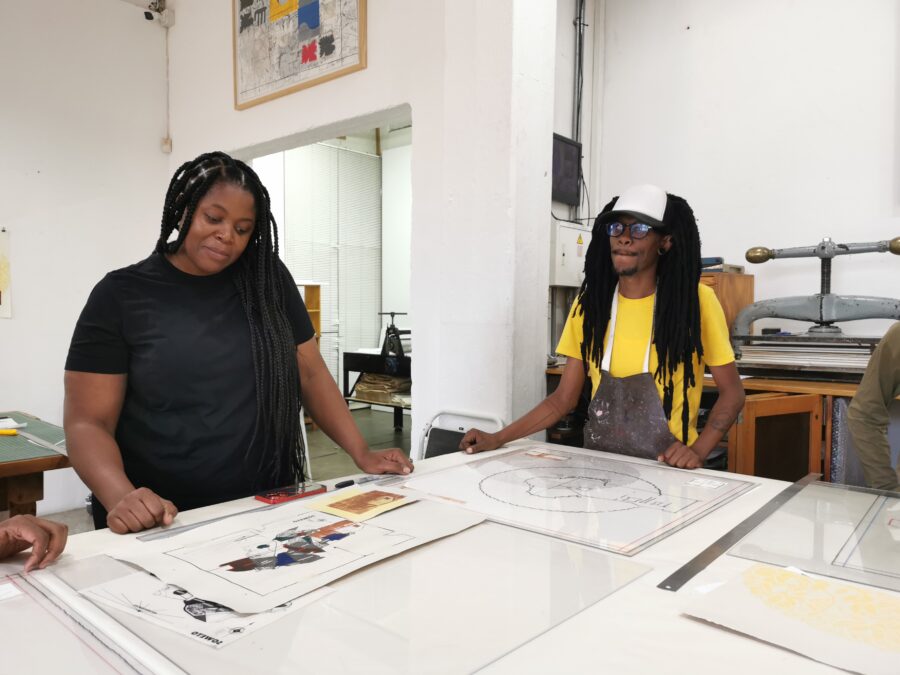

In February 2024 we welcomed Soweto based artist and photographer Hoek Swaratlhe to the David Krut Workshop where he and printmaker Sbongiseni Khulu collaborated on a series of unique prints titled “Palimpsest”. In the series Swaratlhe studies evolving landscapes and spotlights the social inequities endured by indigenous people of South Africa as exhibited by the racial disparities between living quarters designed for European and Non-European South.


Swaratlhe’s photographic works capture fleeting moments of tranquillity within urban communities while shedding light on the socio-political struggles they face. Recently, he has turned his lens towards the NE 51 houses (Non-European houses of 1951) in Soweto, otherwise known as “matchbox houses,” which were the result of segregation embedded research conducted by the National Building Research Institute between 1948 and 1951.
Soweto stands at the epicentre of Swaratlhe’s works, not only for its notable connotations as the country’s largest black urban complex due to redlining, but also as it links to the artist’s own upbringing.
“Growing up in a 4-roomed house I have experienced [first-hand] black life and how 4-roomed houses played a role in history… as such I’ve recently found myself cycling around the township as a ‘flâneur’ (a French term used by nineteenth-century French poet Charles Baudelaire to identify an observer of modern urban life). I saw [more and more] people renovating their 4 roomed houses so I developed research on township architecture using pseudo-scientific deadpan photography as my practice. In conjunction with that I also outsourced some information from Douglas Calderwood’s thesis about NE51”, Swaratlhe reflects.



In the course of the collaboration Khulu and Swaratlhe explored overlaying different elements to create prints that captured both the essence of printmaking and photography. Elements such as Swaratlhe’s own photographs, drawings and found materials sourced from his continued research. At the heart of the explorations is a commitment to pronto lithography and collage using pieces of traditional Japanese papers (Hosho and Tosa washi). A technique that allows for the inclusion of colour and various other information without needing the composition to be finalized on a matrix before printing through a press. This layered approach invites viewers to explore the intricate interplay of infomation and allows Swaratlhe to assume the position of a city planner whilst constructing the layout of the works.



In addition to lithography, Swaratlhe implements blind embossing/printing of fabric, challenging the viewer to identify the lace patterns found in household curtains and doilies not just as found objects but colloquial signifiers for the past, a furnished house turned home, and a mycelium thread that parallels that of city planning maps. As such his images of houses are often coupled with either of the two aforementioned threads, alluding to the softened confines by which its inhabitants are bound. This notion is further substantiated by the use of architectural floor plans, thus transcending Swaratlhe’s gaze from that of an observer to that of a historian. In his own words Swaratlhe says, “This project is for educational and archive purposes. I want to preserve the history of 4-roomed houses as an archive for the coming generation”.

Swaratlhe’s career includes collaborations with Basement in the Arts magazine in 2014, a residency at the Kopanong Art Studio Residency Programme from 2015 to 2016, enrollment in the Market Photo Workshop’s Advanced Programme in Photography in 2018, and participation in the FUJIFILM showcase “Take Ten” in 2022. He was also one of two recipients of the Media and Advocacy Photography Mentorship in the same year, leading to his first solo exhibition titled “4Dladla” in 2022. In 2023, he joined Mary Sibande and Lawrence Lemaoana in the “Occupying the Gallery” traveling exhibition, collaborating with different print workshops and galleries such as LL Editions, Artist Proof Studios, Danger Gevaar Ingozi Studio, Gallery 1 Keyes Art Mile, SMAC Gallery, Johannesburg. In 2024, he participated in the group exhibition “Bazobuya” curated by Lawrence Lemaoana, displayed at the KZNSA Gallery as well as win the 1st prize in the 3rd annual Umsizi Nopende award. Hoek has also recently been awarded the 1st prize in the 3rd annual uMsizi noPende Visual Art Project.